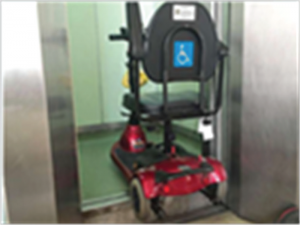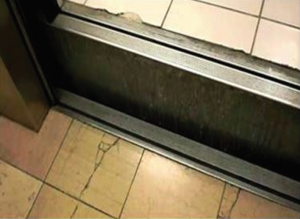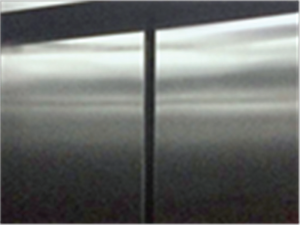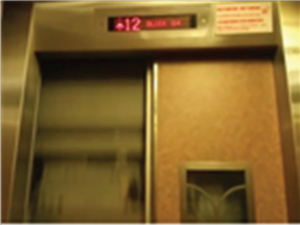Accessibility Considerations for Elevators

Wheelchair have a hard time going into the lift due to elevator car landing gap

Elevator car landing gap

Faulty door operation of elevator car

Example of faulty elevator door
In designing and installing elevators, it is required that the internal car’s dimensions allow moderately easy accessibility and manoeuvrability for persons in wheelchairs [1]. In circumstances where elevator size does not allow a person using a wheelchair to turn around, a mirror can be installed on the rear wall [2]. Designers are required to ensure that elevator controls are readily accessible to any user of diverse capabilities (e.g. 1200mm as the maximum height of the buttons; provision of Braille and tactile characters on the left of control panel button), as well as provide automatic verbal announcements that announce floor levels. Tactile and visual information be provided at a 45-degree angle from the wall so that standing people and people with visual impairments can read the characters. Install at least two sets of call buttons; one for people who are standing (higher set) and for people who are seated or of short stature (lower set). Provide a large illuminated floor indicator on a pad above the hall call buttons to indicate the elevator’s location.
As shown in the above images, some elevator defects which cause harm and injury to passengers are due to faulty door operations and/or the elevator car landing gap. It is advisable that the following guidelines be considered during elevator repair and maintenance:
• Access to escalator or passenger conveyor shall be barred by suitable devices. Notices/signage such as
“No access” or “No entry” must be provided (SS 626:2017).
• Adhere to the inspection criteria for safety of escalators as per JIS A 4302:2006. Upgrade the control system, braking, and motor types. Include a micro-processor controller that will electronically monitor and control motor rotation to ensure that the elevator car accurately stops at floor level [3]. (See also ASME A18.1-1999, ASME A18.1 (2005) and ASME A17.1-2000).
• Review levelling of car to ensure the value is acceptable by standards to avoid risk of passengers tripping and falling (e.g. wheelchair users) [4]. Always ensure that the Permit to operate (PTO) is displayed in the lift(s) [5].
• Inspect elevator door and guides, shoes, and tracks. They should not show any permanent deformation and elastic deformation greater than 15mm (when force >300 N is applied to area of 5cm2 at the centre of the door panels at a right angle) (SS 550:2009). (See also ASME A18.1-1999, ASME A18.1-2003 and ASME A17.1-2000).
• Review the service call frequency for issues pertaining to the door, since increased service calls signify the need to upgrade/replace door operators [5].
Refer also to the MEP Systems for additional design, construction and maintenance guidelines pertaining to the mechanical and electrical systems for elevators.
References
[1] Office of Housing and Construction Standards (2014). The Building Access Handbook Building Requirements for Persons with Disabilities from British Columbia Building Code 2012 including Illustrations and Commentary. British Columbia: Office of Housing and Construction Standards.
[2] Canadian Human Rights Commission (2007). International Best Practices in Universal Design: A Global Review (Rev. ed.). Canada: Canadian Human Rights Commission.
[3] Balmer, D. (2015). Single Speed Elevators: Time to Retire. Retrieved on March 22, 2017 from http:// www.skyline-elevator.com/wp-content/ uploads/ 2010 /09/SingleSpeedElevators.pdf.
[4] Building and Construction Authority (2016). Building Maintenance and Strata Management Act. (Lift, Escalator and Building Maintenance) Regulations 2016. Singapore: BCA.
[5] Piper, J. (2006). Avoiding Elevator Breakdowns. Retrieved on March 22, 2017 from http://www . facilities net.com/elevators/article/Keeping-Up-To-Avoid-Going-Down-Facilities-Management-Elevators-Feature — 4810.
Normative References/Standards Referred to for Elevator Accessibility
• ASME A17.1-2000 — Safety Code for Elevators and Escalators
• ASME A18.1-1999 and ASME A18.1-1999 — Safety Standard for Platform Lifts and Stairway Chairlifts
• ASME A18.1 (2005) — Safety Standard for Platform Lifts and Stairway Chairlifts
• JIS A4302:2006 — Inspection Standard of Elevator, Escalator and Dumbwaiter
• SS 626:2017 — Code of practice for design, installation and maintenance of escalators and moving walks
• SS 550:2009 — Code of practice for installation, operation and maintenance of electric passenger and goods lifts